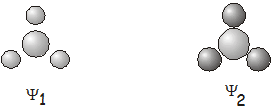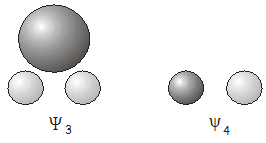1.21: Розв'язування світських рівнянь
- Page ID
- 17556
Матрична постановка множини лінійних рівнянь
Як ми вже бачили, будь-який набір лінійних рівнянь може бути переписаний як матричне рівняння\(A\textbf{x}\) = \(\textbf{b}\). Linear equations are classified as simultaneous linear equations or homogeneous linear equations, depending on whether the vector \(\textbf{b}\) on the RHS of the equation is non-zero or zero.
Для множини одночасних лінійних рівнянь (ненульових\(\textbf{b}\)) it is fairly apparent that if a unique solution exists, it can be found by multiplying both sides by the inverse matrix \(A^{-1}\) (since \(A^{-1}A\) on the left hand side is equal to the identity matrix, which has no effect on the vector \(\textbf{x}\))
\[\begin{array}{rcl} A\textbf{x} & = & \textbf{b} \\ A^{-1}A\textbf{x} & = & A^{-1}\textbf{b} \\ \textbf{x} & = & A^{-1}\textbf{b} \end{array} \label{21.1}\]
На практиці існують простіші матричні методи розв'язання одночасних рівнянь, ніж знаходження зворотної матриці, але ці тут нас не повинні стосуватися. У розділі 8.4 ми виявили, що для того, щоб матриця мала зворотну, вона повинна мати ненульовий детермінант. Так як\(A^{-1}\) must exist in order for a set of simultaneous linear equations to have a solution, this means that the determinant of the matrix \(A\) must be non-zero for the equations to be solvable.
Зворотне вірно для однорідних лінійних рівнянь. У цьому випадку множина рівнянь має рішення лише в тому випадку, якщо визначник\(A\) is equal to zero. The secular equations we want to solve are homogeneous equations, and we will use this property of the determinant to determine the molecular orbital energies. An important property of homogeneous equations is that if a vector \(\textbf{x}\) is a solution, so is any multiple of \(\textbf{x}\), meaning that the solutions (the molecular orbitals) can be normalized without causing any problems.
Розв'язування орбітальних енергій та коефіцієнтів розширення
Згадаймо світські рівняння для\(A_1\) orbitals of \(NH_3\) derived in the previous section
\[\begin{array}{rcl} c_1(H_{11} - ES_{11}) + c_2(H_{12} - ES_{12}) & = & 0 \\ c_1(H_{12} - ES_{12}) + c_2(H_{22} - ES_{22}) & = & 0 \end{array} \label{21.2}\]
де\(c_1\) and \(c_2\) are the coefficients in the linear combination of the SALCs \(\phi_1\) =\(s_N\) and \(\phi_2\) =\(\dfrac{1}{\sqrt{3}}(s_1 + s_2 + s_3)\) використовується для побудови молекулярної орбіти. Запис цієї множини однорідних лінійних рівнянь у матричній формі дає
\[\begin{pmatrix} H_{11} - ES_{11} & H_{12} - ES_{12} \\ H_{12} - ES_{12} & H_{22} - ES_{22} \end{pmatrix} \begin{pmatrix} c_1 \\ c_2 \end{pmatrix} = \begin{pmatrix} 0 \\ 0 \end{pmatrix} \label{21.3}\]
Щоб рівняння мали рішення, визначник матриці повинен дорівнювати нулю. Виписання детермінанта дасть нам поліноміальне рівняння в\(E\) that we can solve to obtain the orbital energies in terms of the Hamiltonian matrix elements \(H_{ij}\) and overlap integrals \(S_{ij}\). The number of energies obtained by ‘solving the secular determinant’ in this way is equal to the order of the matrix, in this case two.
Світський детермінант для рівняння\(\ref{21.3}\) is (noting that \(S_{11}\) = \(S_{22} = 1\) since the SALCs are normalized)
\[(H_{11} - E)(H_{22} - E) - (H_{12} - ES_{12})^2 = 0 \label{21.4}\]
Розширення і збір термінів в\(E\) gives
\[E^2(1-S_{12}^2) + E(2H_{12}S_{12} - H_{11} - H_{22}) + (H_{11}H_{22} - H_{12}^2) = 0 \label{21.5}\]
які можна вирішити за допомогою квадратичної формули, щоб дати енергії двох молекулярних орбіталей.
\[E_\pm = \dfrac{-(2H_{12}S_{12} - H_{11} - H_{22}) \pm \sqrt{(2H_{12}S_{12} - H_{11} - H_{22})^2 - 4(1-S_{12}^2)(H_{11}H_{22} - H_{12}^2)}}{2(1-S_{12}^2)} \label{21.6}\]
Для отримання числових значень енергій нам потрібно оцінити інтеграли\(H_{11}\), \(H_{22}\), \(H_{12}\), and \(S_{12}\). This would be quite a challenge to do analytically, but luckily there are a number of computer programs that can be used to calculate the integrals. One such program gives the following values.
\[\begin{array}{rcl} H_{11} & = & -26.0000 \: eV \\ H_{22} & = & -22.2216 \: eV \\ H_{12} & = & -29.7670 \: eV \\ S_{12} & = & \: 0.8167 \: eV \end{array} \label{21.7}\]
Коли ми підставляємо їх у наше рівняння для енергетичних рівнів, ми отримуємо:
\[\begin{array}{rcl} E_+ & = & \: 29.8336 \: eV \\ E_- & = & -31.0063 \: eV \end{array} \label{21.8}\]
Тепер у нас є орбітальні енергії, і наступним кроком є пошук орбітальних коефіцієнтів. Коефіцієнти для орбіти енергії\(E\) are found by substituting the energy into the secular equations and solving for the coefficients \(c_i\). Since the two secular equations are not linearly independent (i.e. they are effectively only one equation), when we solve them to find the coefficients what we will end up with is the relative values of the coefficients. This is true in general: in a system with \(N\) coefficients, solving the secular equations will allow all \(N\) of the coefficients \(c_i\) to be obtained in terms of, say, \(c_1\). The absolute values of the coefficients are found by normalizing the wavefunction.
Так як світські рівняння для орбіталей енергії\(E_+\) and \(E_-\) are not linearly independent, we can choose to solve either one of them to find the orbital coefficients. We will choose the first.
\[(H_{11} - E_{\pm})c_1 + (H_{12} - E_{\pm}S_{12})c_2 = 0 \label{21.9}\]
Для орбіти з енергією\(E_-\) = -31.0063 eV, substituting numerical values into this equation gives
\[\begin{array}{rcl} 5.0063 c_1 - 4.4442 c_2 & = & 0 \\ c_2 & = & 1.1265 c_1 \end{array} \label{21.10}\]
Таким чином, молекулярна орбіталь
\[\Psi = c_1(\phi_1 + 1.1265\phi_2) \label{21.11}\]
Нормалізація знайти константу\(c_1\) (by requiring \(\label\Psi|\Psi \rangle\) = 1) дає
\[\begin{array}{rcll} \Psi_1 & = & 0.4933\phi_1 + 0.5557\phi_2 & \\ & = & 0.4933s_N + 0.3208(s_1 + s_2 + s_3) & (\text{substituting the SALCs for} \: \phi_1 \: \text{and} \: \phi_2) \end{array} \label{21.12}\]
Для другої орбітальної, з енергією\(E_+\) = 29.8336 eV, the secular equation is
\[\begin{array}{rcl} -55.8336c_1 - 54.1321c_2 & = & 0 \\ c_2 & = & -1.0314c_1 \end{array} \label{21.13}\]
даруючи
\[\begin{array}{rcll} \Psi_2 & = & c_1(\phi_1 - 1.0314\phi_2) & \\ & = & 1.6242\phi_1 - 1.6752\phi_2 & \text{(after normalization)} \\ & = & 1.6242s_N -0.9672(s_1 + s_2 + s_3) \end{array} \label{21.14}\]
Ці два\(A_1\) molecular orbitals \(\Psi_1\) і\(\Psi_2\) , один зв'язок і один антібондінг, показані нижче.

Решта два SALC, що випливають з\(s\) orbitals of \(NH_3\):
\[\phi_3 = \dfrac{1}{\sqrt{6}}\begin{pmatrix} 2s_1 - s_2 - s_3 \end{pmatrix}\]
і
\[\phi_4 = \dfrac{1}{\sqrt{2}} \begin{pmatrix} s_2 - s_3 \end{pmatrix}\]
утворюють ортогональну пару молекулярних орбіталів\(E\) symmetry. We can show this by solving the secular determinant to find the orbital energies. The secular equations in this case are:
\[\begin{array}{rcl} c_1(H_{33} - ES_{33}) + c_2(H_{34} -ES_{34}) & = & 0 \\ c_1(H_{34} -ES_{34}) + c_2(H_{44} - ES_{44}) & = & 0 \end{array} \label{21.15}\]
Розв'язування світської детермінанти дає
\[E_\pm = \dfrac{-(2H_{34}S_{34} - H_{33} - H_{44}) \pm \sqrt{(2H_{34}S_{34} - H_{33} - H_{44})^2 - 4(1-S_{34}^2)(H_{33}H_{44} - H_{34}^2)}}{2(1-S_{34}^2)} \label{21.16}\]
Необхідні інтеграли:
\[\begin{array}{rcl} H_{33} & = & -9.2892 \: eV \\ H_{44} & = & -9.2892 \: eV \\ H_{34} & = & 0 \\ S_{34} & = & 0 \end{array} \label{21.17}\]
Використовуючи той факт, що\(H_{34}\) = \(S_{34} = 0\), the expression for the energies reduces to
\[E_\pm = \dfrac{(H_{33} + H_{44}) \pm (H_{33} - H_{44})}{2} \label{21.18}\]
даруючи\(E_+\) = \(H_{33}\) = -9.2892 eV and \(E_-\) = \(H_{44}\) = -9.2892 eV. Each SALC therefore forms a molecular orbital by itself, and the two orbitals have the same energy; the two SALCs form an orthogonal pair of degenerate orbitals. These two molecular orbitals of \(E\) symmetry are shown below.

